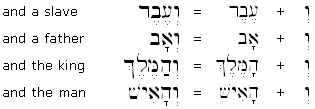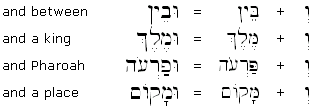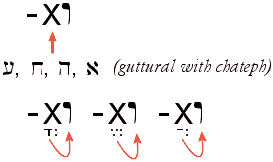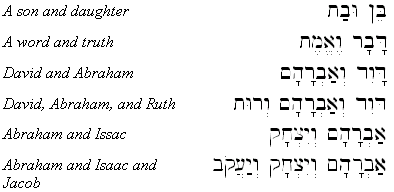|
Introduction to the Hebrew Conjunction
Like the definite article, the word "and" in Hebrew functions as a prefix to Hebrew words. To make a Hebrew word (of either gender) part of a connecting sequence, you add a Vav before the noun. Sometimes the vowel under the Vav changes, depending on the consonant that appears at the beginning of the word. This function of the Vav is often referred to as the "Conjunctive Vav."
CASE 1: The Basic Form
The basic form of the conjunction is a Vav pointed with a simple Sheva:

For example:

In these cases, notice that when the conjunctive Vav is added to the noun, there are no vowel changes. Note also that the Vav can be joined to a noun with the definite article.
CASE 2: Before "BMP" letters
When the Conjunctive Vav is prefixed to words beginning with Bet, Mem, or Pey ("BMP letters), the dagesh is lost (since the letter is now preceded by a vowel sound), and the conjunction takes the form of a Shureq:

For example:

In addition, the Conjunctive Vav may form as Shureq before all consonants that are pointed with a simple Sheva (except for Yod, see below):

CASE 3: Before Gutturals with Chateph Forms
When the Conjunctive Vav is prefixed to a guttural letter that has a reduced (chateph) vowel, the vav will take the corresponding unreduced vowel as its vowel:

For example:

Notice how the Chateph Segol of the Aleph (in emet) transfers its corresponding unreduced form (Segol) to the Vav, and how the Chateph Qamets (in choli) transfers its unreduced Qamets to the Vav.
Since Chateph vowels are a form of vocal Sheva, you can see that by adding a Conjunctive Vav you would have two vocal shevas in a row -- which is forbidden in Hebrew. This vocalic transfer is sometimes called the Second Rule of Sheva.
There is an exception to this rule for the Name of God, elohim:

When the Vav is added, the Chateph Segol of the Aleph (in elohim) transfers its corresponding unreduced form (Segol) to the Vav but in this case the Aleph goes quiescent. The Vav "compensates" by lengthening from Segol to Tsere. Phew! Better to just remember the form (this one is hardly confused with other words, anyway).
CASE 4: Before Monosyllabic (single-syllable) words
In the case of single syllable words (as well as some segolate nouns) the vowel under the Conjunctive Vav is Qamets:

Example:

CASE 5: Before Yod with Sheva
In the case of a word that begins with a Yod having a Sheva, the Conjunctive Vav combines to form a Chireq Yod vowel:

Examples:

The First Rule of Sheva
The last examples illustrate a phonetic pattern that occurs so often that grammarians have dubbed it a "rule." The first rule of Sheva states that two shevas at the start of a word results in Chireq in a closed syllable:

Thus:

Assorted Examples of the Conjunctive Vav

Quick Summary:
The conjunctive Vav prefix is normally just a Vav with a Sheva (וְ), though it can change in the following cases:
- When the Vav prefix is appended before a "BMP" letter (Bet, Mem, Pey) it normally takes a Shureq (וּ) vowel mark.
- When the Vav prefix is appended before an opening Sheva, it also normally takes a Shureq (וּ) vowel mark.
- When the Vav prefix is appended before a letter taking a "chateph" vowel, it can appear with Patach, Segol, or Qametz vowels (i.e., וֶ).
- When the Vav prefix is appended before a biconsonantal or monosyllabic word, it takes the Qametz vowel (וָ).
- In the case the reversing "Vav Consecutive" (used in narratives), the Vav prefix takes a patach followed by dagesh (if possible) on the following letter.
Section Exercises
- Infer additional Hebrew vocabulary from the examples provided on the page. Use your Hebrew dictionary and write out a new flashcard for each word.
- Memorize the basic rules for adding the Conjunctive Vav to nouns beginning with non-guttural consonants.
- Memorize the basic rules for adding the Conjunctive Vav to nouns beginning with guttural consonants.
<< Return
|


